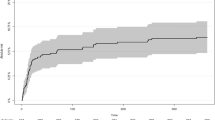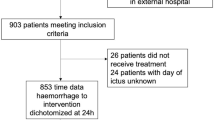Abstract
Background
It is well recognized that intraoperative aneurysm rupture (IAR) is a serious event that is difficult to manage and has a relatively serious influence on a patient’s prognosis. The aim of this study was to evaluate the prognostic value of different bleeding positions of IAR in patients, and to describe the technique that the authors have used to clip the ruptured aneurysms.
Methods
From May 2009 to March 2012, a total of 148 aneurysms in 135 consecutive patients in our institution underwent clipping surgeries, and 31 IARs occurred in 30 patients. The clinical data of all patients were retrospectively analyzed. Statistics analysis was performed to analyze possible factors of different bleeding positions of IARs, to assist observation.
Results
Outcome was estimated by Glasgow outcome scale via following up or calling back within 1, 3, and 6 months after surgery: 94 patients were 5’, 23 patients were 4’, nine patients were 3’, two patients were 2’ and eight patients were 1’. There was no significant difference between the outcome of IAR and that of no intraoperative aneurysm rupture (NIAR) in Hunt–Hess groups 0–III (P = 0.802) and Hunt–Hess groups IV–V (P = 0.229), and the different bleeding positions were shown to be an important factor that significantly influences the patients’ prognosis (P = 0.001).
Conclusions
Different bleeding positions of IAR have a significant impact on surgical outcome; IAR of the neck is the most devastating complication. If surgeons take appropriate measures according to different bleeding positions, the efficiency, accuracy and security of the operation will be improved.




Similar content being viewed by others
Abbreviations
- IAR:
-
Intraoperative aneurysm rupture
- NIAR:
-
No intraoperative aneurysm rupture
- DSA:
-
Digital subtraction angiography
- CT:
-
Computer tomography
- CTA:
-
Computer tomography angiography
- ACoAA:
-
Anterior communication artery aneurysm
- PCoAA:
-
Posterior communicating artery aneurysm
- MCAA:
-
Middle cerebral artery aneurysm
- ACAA:
-
Anterior circulation arteries aneurysm
- ICAA:
-
Internal carotid artery aneurysm
- GOS:
-
Glasgow outcome scale
- VIB:
-
Volume of intraoperative blood loss
References
Andrade GC, Braga FM (2002) Intraoperative rupture in the aneurysmal neck: suggestion for surgical management [inPortuguese]. Arq Neuropsiquiatr 60:666–669
Batjer H, Samson D (1986) Intraoperative aneurysmal rupture: Incidence, outcome, and suggestions for surgical management. Neurosurgery 18:701–707
Daniel L, Robert F (2011) Cotton-Clipping Technique to Repair Intraoperative Aneurysm Neck Tear: A Technical Note. Neurosurgery 68:294–299
French LA, Chou SN, Long DM (1968) The direct approach to intracranial aneurysms. Clin Neurosurg 15:117–132
French LA, Chou SN, Story JL, Schultz EA (1966) Aneurysm of the anterior communicating artery. J Neurosurg 24:1058–1062
French LA, Ortiz-Suarez HJ (1974) Anterior communicating artery aneurysms: Technique of operation and results. Clin Neurosurg 21:115–119
Fujimura M, Nishijima M, Umezawa K, Hayashi T, Mino Y, Sakuraba T, Midorikawa H (2003) Optochiasmal arachnoiditis following cotton wrapping of anterior communicating artery aneurysm treated by surgical removal of granuloma. J Clin Neurosci 10:254–257
Giannotta SL, Oppenheimer JH, Levy ML, Zelman V (1991) Management of intraoperative rupture of aneurysm without hypotension. Neurosurgery 28:531–536
Houkin K, Kuroda S, Takahashi A, Takikawa S, Ishikawa T, Yoshimoto T, Itamato K (1999) Intra-operative premature rupture of cerebral aneurysms: Analysis of the causes and management. Acta Neurochir (Wien) 141:1255–1263
Inagawa T (1999) Dissection from fundus to neck for ruptured anterior and middle cerebral artery aneurysms at the acute surgery. Acta Neurochir (Wien) 141:563–570
Jamin M, Lesoin F, Lozes G (1984) Prognosis with 500 ruptured and operated intracranial arterial aneurysms. Surg Neurol 21:13–18
Kopitnik TA, Horowitz MB, Samson DS (2000) Surgical management of intraoperative aneurysm rupture. In: Schmidek HH, Sweet WH (eds) Operative neurosurgical techniques, 2nd edn. WB Saunders, Philadelphia, pp 1275–1281
Lanzino G, Spetzler RF (2003) Clip wrapping for partial avulsion of the aneurysm neck. Technical note. J Neurosurg 99:931–932
Lavin P (1997) Muslin-induced optochiasmatic arachnoiditis? Neurosurgery 20(3):505
Lawton MT, Du R (2005) Effect of the neurosurgeon’s surgical experience on outcomes from intraoperative aneurysmal rupture. Neurosurgery 57:9–15
Leipzig TJ, Morgan J, Horner TG, Payner T, Redelman K, Johnson CS (2005) Analysis of intraoperative rupture in the surgical treatment of 1694 saccular aneurysms. Neurosurgery 56:455–468
Menovsky T, de Vries J, Grotenhuis JA (2011) Cotton-clipping technique: piece of smashed muscle as an alternative. Neurosurgery 69:1183–1185
Paul RL, Arnold JG (1970) Operative factors influencing mortality in intracranial aneurysms surgery: Analysis of 186 consecutive cases. J Neurosurg 32:289–294
Peerless SJ, Hernesniemi JA, Gutman FB, Drake CG (1994) Early surgery for ruptured vertebrobasilar aneurysms. J Neurosurg 80:643–649
Pertuiset B, van Effenterre R, Goutorbe J, Yoshimasu N (1974) Management of aneurysmal rupture during surgery, using bipolar coagulation, deep hypotension, and the operating microscope. Acta Neurochir (Wien) 30:195–205
Poppen JL (1960) Aneurysm of the middle cerebral artery. In: Poppen JL (ed) An atlas of neurosurgical techniques. WB Saunders Co, Philadelphia, pp 160–161
Sandalcioglu IE, Schoch B, Regel JP, Wanke I, Gasser T, Forsting M, Stolke D, Wiedemayer H (2004) Does intraoperative aneurysm rupture influence outcome? Analysis of 169 patients. Clin Neurol Neurosurg 106:88–92
Schramm J, Cedzich C (1993) Outcome and management of intraoperative aneurysm rupture. Surg Neurol 40:26–30
Seifert V, Stolke D, Trost HA, Brüning A, Schäffer J (1989) Incidence, management, and outcome of patients with premature rupture of cerebral aneurysms during surgery. In: Frowein RA, Brock M, Klinger M (eds) Advances in Neurosurgery, 17th edn., pp 203–207
Taylor CL, Selman WR (1998) Temporary vascular occlusion during cerebral aneurysm surgery. Neurosurg Clin N Am 9:673–679
Taylor CL, Yuan Z, Selman WR, Ratcheson RA, Rimm AA (1995) Cerebral arterial aneurysm formation and rupture in 20,767 elderly patients: hypertension and other risk factors. J Neurosurg 83:812–819
van Lindert EJ, Böcher-Schwarz HG, Perneczky A (2001) The influence of surgical experience on the rate of intraoperative aneurysm rupture and its impact on aneurysm treatment outcome. Surg Neurol 56:151–158
Yasargil MG, Smith RD (1982) Management of aneurysms of anterior circulation by intracranial procedures. In: Youmans JR (ed) Neurological surgery, vol 3. WB Saunders Co, Philadelphia, pp 1663–1696
Acknowledgments
YKX, ZY, ZHZ and ZSK performed the majority of this study and wrote the manuscript; ZHZ, XY, HL and SLH provided the material of the patients from the database. All authors have read and approved the content.
Conflict of interest
None.
Author information
Authors and Affiliations
Corresponding author
Rights and permissions
About this article
Cite this article
Zhen, Y., Yan, K., Zhang, H. et al. Analysis of the relationship between different bleeding positions on intraoperative rupture anterior circulation aneurysm and surgical treatment outcome. Acta Neurochir 156, 481–491 (2014). https://doi.org/10.1007/s00701-013-1953-0
Received:
Accepted:
Published:
Issue Date:
DOI: https://doi.org/10.1007/s00701-013-1953-0




